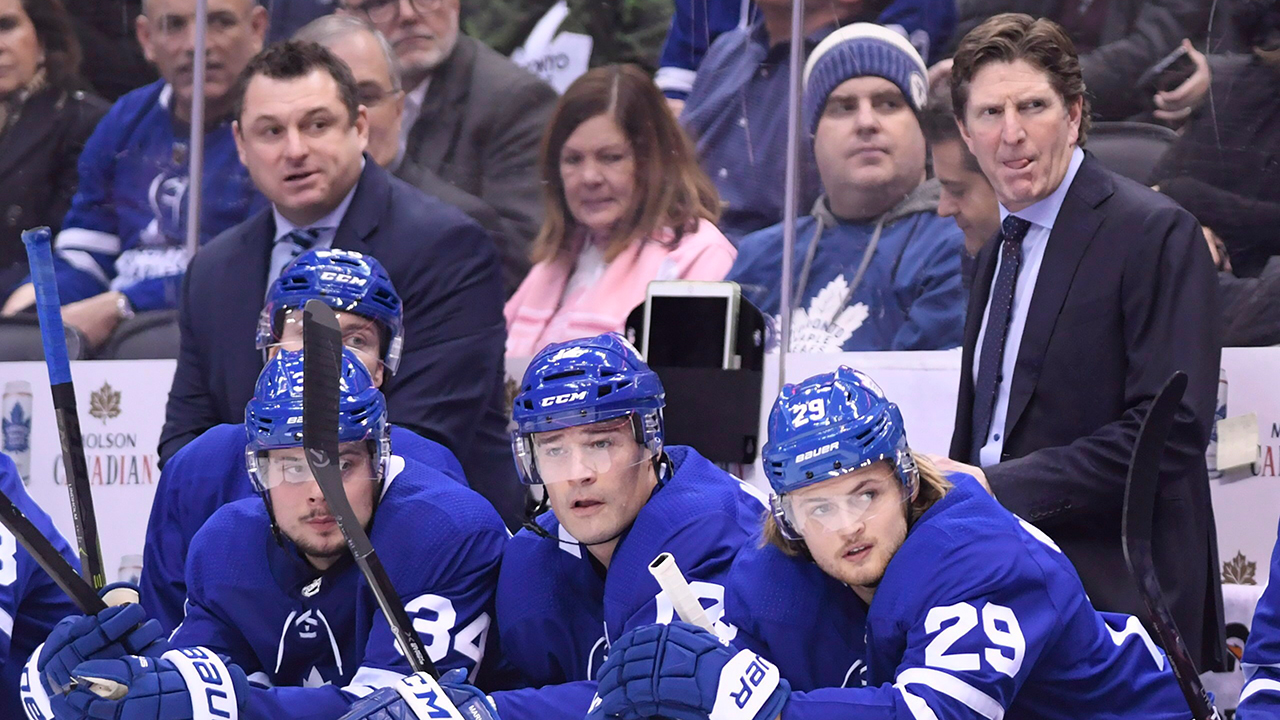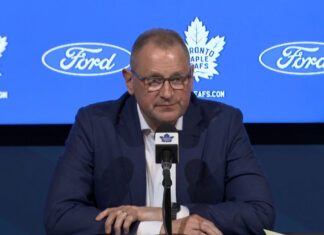When it comes to the Toronto Maple Leafs forward group, the combinations have been anything but stable so far this season.
Auston Matthews has missed 14 of 31 games, William Nylander held out, and Josh Leivo played 27 games before getting traded. Kasperi Kapanen and Andreas Johnsson started down the roster, struggled a little, and coincidentally became impact players when they moved up the lineup.
In the long run of the season, this is going to be a good thing for the Leafs.
The first reason is obvious – Kasperi Kapanen and Andreas Johnsson have seized their opportunities so far and have made it clear they deserve bigger roles than originally given. Remember, Kapanen started behind Connor Brown in the depth chart and Johnsson was struggling to get into the lineup at one point. Now they are Matthews’ wingers.
The second benefit is the opportunity for new looks. For Matthews, he has played almost exclusively with William Nylander and Zach Hyman at 5v5 the past two seasons. Last year, the only other forward he played 100+ minutes with was Connor Brown. This season, he has already played over 170+ minutes with Patrick Marleau and Kapanen. It’s probably fair to state that all of Nylander, Hyman, and Johnsson have a chance of cracking 100+ minutes with Matthews as well.
When the Leafs are putting on a poor performance and Babcock decides to shake it up, he has options now. Against Detroit, as Nylander lost his legs, Kapanen shifted up and it generated a spark. It was circumstantial, but now there is also some evidence to bank on and a different look and feel to the line combinations if the team is flat.
The third component is match-ups. This is not the norm for the Leafs over the past few seasons. Babcock has kept his lines remarkably constant over two seasons unless injury called for a shift. Now, in-game adjustments are much more palatable.
Part of the Leafs’ lack of line changes is that they have been remarkably healthy. Last season, five forwards played 82 games. Tyler Bozak and JVR played 81, while Nazem Kadri played 78. Auston Matthews had the only notable injury. The lines were essentially, “set it and forget it.”
Not this season, though. The Leafs are going to benefit from that when they are in the playoffs and match-ups aren’t working — they can move guys around with a comfortable understanding of what different combinations can do.
Now that they are finally healthy, we’re seeing new growing pains as the coaching staff sorts out roles and combinations while trying to get everyone into a flow at the same time. It’s the middle of December and this is one of the best teams in the league standings-wise. This is a great time to experiment, and the team will be happy at the end of the season that they have data on all these different looks that will help them figure out playoff lines and adjustments in what they hope will be a lengthy run.
Notes
– First, on the Josh Leivo trade: Kyle Dubas admitted that the organization and Leivo essentially had an agreement in place to move him if he wasn’t going to play, which makes sense considering the return. The organization does want the Marlies to do well (more on that in the next note), but on the value of the deal, they traded what looks like a legitimate NHLer for what is most likely a career AHLer, with no draft pick to go along with it. Leivo has played four games for Vancouver, playing between 13:08 and 16:53, and has nine shots on goal and three points.
Michael Carcone, who they got back one for one, is a 22-year-old, 5’10 undrafted forward who put up 27 points in 68 AHL games last season. He has started hot this year with 17 points in 20 games, so maybe there’s something there, but the odds are not in the Leafs’ favour. They had a deal and it was honoured — so be it, but the value is not even close to being there on this one.
– I do think the Leafs will miss Leivo’s size and ability on the walls to cycle, which is something they generally lack. He clearly couldn’t play left wing, though, and he was never going to pass Marner, Nylander, or Kapanen on the right. It was him or Brown, and Brown is a staple on the penalty kill and a checker that Babcock is fond of.
– The Marlies have made some recent moves, trading away goalie Jeff Glass for future considerations, adding the aforementioned Carcone, and swapping Adam Cracknell for Steven Olesky. The organization wants young players playing in big games. The Marlies are currently tied for sixth in their division and they’ve given up more goals than any other team in the league (.866 save percentage). It’s not totally the defense that’s to blame. The organization lost their goaltending depth this summer and the Marlies are paying the price. They are sixth in the league in goals for and can score. They do miss Martin Marincin and Justin Holl, though (adding a veteran like Olesky was not surprising in this regard).
– Quiet but tidy business to sign Calle Rosen to a two-year deal with a $750,000 annual average. First off, the Leafs are flexing their financial muscle with that guaranteed money to keep him on this side of the pond. More importantly, though, he has a legitimate chance to become a contributing NHLer. He was close to making the team out of training camp in preseason but struggled as preseason games wore on, particularly with giveaways under pressure. In the AHL, he has 19 points in 24 games so far this season, which is good for second on the team in scoring.
– When the Leafs were down against the Red Wings, Babcock blew up the lines, as mentioned above. One thing that was interesting is that they had Jake Gardiner move to the right side and Morgan Rielly stayed on the left. Under Randy Carlyle, Rielly generally played on the right side on that pairing as Gardiner was uncomfortable there. The situations are different (the Leafs were down and going all out for offense vs. a regular game from start to finish), but it’s a change.
– Good note by Ray Ferraro on William Nylander staying late at the optional game day skate to work on his game. He has shown flashes to this point, but his timing is way off. Against Carolina, the puck went up the wall in the neutral zone right by the Canes bench and the defense was caught in the middle of a change. Nylander swooped in to take the puck on what should have been a 2v1, but he lost the handle and Carolina recovered to the point where the Leafs didn’t get a shot off. Later in the game, he got another 2v1 and set up Marleau backdoor for a relatively easy goal. His game is going to come and there’s nothing to worry about. This is just what happens when you miss the first few months of the season.
Quotes
“Honestly, I was so tired, I just shot it. I knew I was going against a forward so I felt I probably had little more time to get the shot off I wanted so I pulled it in and let it go and I guess the rest is history.”
– Auston Matthews describing his overtime winner against the Sabres
It didn’t get talked about too much, but that goal was a really simple 2v2. It was not really a dangerous opportunity, but when Auston Matthews has the puck off the rush with any sort of space… It’s going to be dangerous.
“They work in the baseball world and the hockey world. We started this a year and a half working on the vision stuff, but we upped it this year because he was so calm in his brain and we wanted to really make sure he was really seeing things clearly, so that you know he will stop that shot once and not have to do a crazy athletic move to stop a second shot when he already saw where it was going to land. And we do it three times a week. He’s working on peripherals, focal points, he’s making sure both eyes are working together and processing things together, and there’s a lot of drills that go with that.”
– High-performance coach Scot Prohaska on the work they do with Frederik Andersen and his vision
Frederik Andersen is so calm in net, not often caught out of position, and rarely forces himself to make crazy saves based on his athleticism. I think this is the next step in the overall goaltending position and Andersen is arguably leading the charge.
“I’m on him right now. We’ve got to get him one in the back of the net, spread the wealth around. I think he’s got a lot of deception in his game and he can be very difficult to read. His ability to look players off and find the passing lanes – I think he can be very similar with his shot… It’s just about being able to fool the goaltender, just trying to be hard to read and trying not to be predictable.”
– John Tavares on Mitch Marner shooting more
I don’t want to nitpick at a guy with 41 points in 31 games, but Mitch Marner does have only six goals and teams are starting to catch onto him, particularly on the power play. Boston played it really well. Against Carolina, he made a slight adjustment and shot it early to try to keep them honest. He doesn’t have to be a 40-goal scorer, but once in a while, he is going to have to shoot to open up space for himself or else more and more opponents are going to figure out they should just collapse on the PP when he has the puck and give him the time and space rather than pressuring him.
5 Things I Think I’d Do
1. I think the Andreas Johnsson – Auston Matthews – Kasperi Kapanen line is working for now and it’s worth keeping together until Nylander gives them absolutely no choice but to move him up (which will happen, for the record). Long term, the plan should still be to have Nylander on that line, but as noted at the beginning of this Notebook, it’s nice to have options.
2. Obviously, that means I think it’s a good thing to have William Nylander play on a lower line until he’s up to full speed.
3. I think I don’t fully understand it, but Frederik Gauthier as the 4C just sort of works regardless of his production. He’s responsible and regularly the high guy that defends well and just seems to fit the role. When playing with Tyler Ennis, he has a 47.96 CF%, but in limited minutes with Par Lindholm, they’re at 41.76 CF%.
4. I think Par Lindholm has been a decent pickup and can play in the NHL, but so far I’ve liked him better on the wing than at center. Depending on the opponent, I think the fourth line is either Ennis – Gauthier – Brown or Lindholm – Gauthier – Brown.
5. I think, with all of this said, we can talk about the lines until we’re blue in the face, but the reality is the team has to, A) play more aggressive; B) hold the puck more in the offensive zone, specifically by cycling; C) Generally be more engaged instead of waiting for odd-man rush and power-play opportunities. This is a really good team, obviously, but that’s the next step.




































